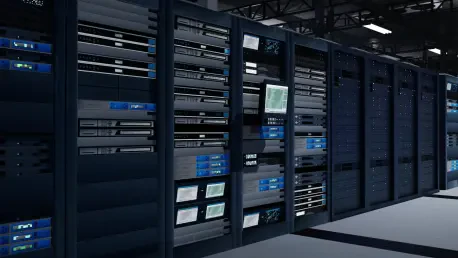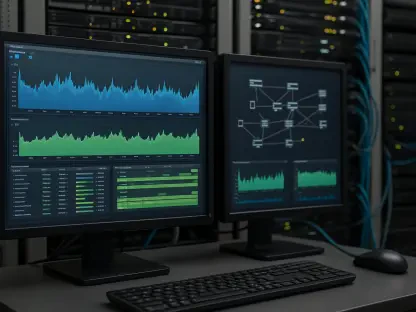In an era where digital connectivity forms the backbone of global business operations, the enterprise network equipment market stands as a critical pillar supporting this transformation, with projections showing unprecedented growth. This sector, encompassing essential hardware like routers, switches, firewalls, and wireless access points, is witnessing high demand as organizations race to keep pace with technological advancements. Projections indicate that this market, valued at $72.3 billion in 2024, is set to soar to an astonishing $179.7 billion by 2035, reflecting a robust compound annual growth rate (CAGR) of 8.5% from 2025 onward. Such growth underscores the pivotal role of networking infrastructure in enabling cloud-based solutions, remote work environments, and data-intensive applications. As enterprises navigate the complexities of digitalization, the need for scalable, secure, and high-performance equipment becomes non-negotiable. This article delves into the key drivers behind this remarkable expansion, explores regional dynamics, and examines the technological trends shaping the future of enterprise networking.
Forces Fueling Market Expansion
The rapid ascent of the enterprise network equipment market is largely driven by the global push toward digital transformation, compelling businesses to overhaul their IT infrastructures for modern demands. As companies across sectors pivot to cloud computing and hybrid IT environments, the necessity for advanced networking hardware becomes paramount. These systems must handle intricate workloads while ensuring seamless connectivity, with technologies like software-defined networking (SDN) and network function virtualization (NFV) leading the charge. By allowing greater flexibility and reducing operational costs compared to traditional setups, these innovations are redefining how enterprises manage their networks. This shift is not merely a trend but a fundamental change in operational strategy, as businesses strive to maintain agility and efficiency in a competitive digital landscape that shows no signs of slowing down.
Another significant catalyst propelling market growth is the widespread adoption of 5G technology, which offers unparalleled speed and reduced latency for enterprise applications. This technological leap is spurring demand for cutting-edge equipment designed to support transformative solutions such as edge computing and artificial intelligence (AI)-powered analytics. Simultaneously, the proliferation of Internet of Things (IoT) devices in industries ranging from healthcare to manufacturing is generating vast amounts of data, requiring robust routers, switches, and wireless solutions to manage real-time processing. The convergence of these advancements highlights a critical need for infrastructure capable of handling increased traffic and complexity. As enterprises integrate more connected devices and leverage data-driven insights, the role of sophisticated network equipment in ensuring operational continuity and innovation becomes ever more vital.
Regional Insights and Emerging Opportunities
North America currently holds the reins as the dominant player in the enterprise network equipment market, bolstered by its advanced IT infrastructure and early embrace of 5G technology. The region benefits from substantial investments in cybersecurity and the presence of leading technology firms, which collectively reinforce its position at the forefront of market development. Europe follows closely, with steady growth driven by stringent regulations like the General Data Protection Regulation (GDPR), which mandate secure networking solutions. Additionally, the increasing adoption of hybrid IT systems in European markets fuels demand for equipment that meets both performance and compliance standards. This blend of innovation and regulatory focus creates a unique environment where enterprises must balance technological advancement with legal obligations, shaping purchasing decisions across the continent.
Meanwhile, Asia-Pacific emerges as the most dynamic region, experiencing the fastest growth due to rapid urbanization and expanding IT sectors in countries like China and India. Government initiatives promoting digitalization, coupled with the aggressive rollout of 5G networks, are key contributors to this surge, particularly in densely populated urban hubs where connectivity demands are soaring. In contrast, regions like Latin America and the Middle East & Africa, while smaller in market share, are gradually gaining traction through expanding telecommunications sectors and efforts to bridge digital divides. However, challenges such as underdeveloped infrastructure and economic constraints temper their progress. These regional disparities illustrate a global market with varied paces of adoption and opportunity, where tailored strategies are essential to address unique local needs and capitalize on emerging potential.
Challenges and Innovations on the Horizon
Despite the promising growth trajectory, the enterprise network equipment market faces significant hurdles that could impact its expansion. High upfront costs for advanced hardware and solutions pose a barrier, especially for small and medium-sized enterprises (SMEs) operating with constrained budgets. The complexity of integrating new technologies with existing legacy systems often leads to operational disruptions and unforeseen expenses, creating hesitation among some organizations. Furthermore, while cybersecurity drives demand for secure equipment, the evolving sophistication of cyber threats presents a persistent challenge, as vulnerabilities in expanding networks become harder to predict and mitigate. These obstacles highlight the need for strategic approaches to adoption, ensuring that financial and technical barriers do not derail the broader push toward digital transformation.
To counter these challenges, vendors are prioritizing innovation and collaboration to stay competitive in a rapidly evolving landscape. The development of AI-powered network management systems marks a significant advancement, enabling predictive maintenance and automated troubleshooting to boost efficiency. There is also a growing focus on sustainable, energy-efficient solutions that align with global environmental goals, appealing to enterprises seeking to reduce their carbon footprint. Strategic partnerships between equipment providers and cloud or telecom firms are enhancing product offerings and extending market reach, particularly in high-growth areas. These efforts demonstrate a proactive response to market demands, positioning vendors to address both current constraints and future needs while fostering resilience and adaptability in enterprise networking solutions.
Future Outlook and Strategic Pathways
Looking toward 2035, the enterprise network equipment market is poised to maintain its upward momentum, propelled by ongoing digital transformation and the integration of emerging technologies. Continued adoption of cloud and hybrid IT models, alongside the expansion of 5G and IoT ecosystems, will sustain demand for advanced networking infrastructure. Vendors who prioritize integrating robust cybersecurity features, energy-efficient designs, and AI-driven capabilities are likely to secure a competitive advantage in this crowded space. The emphasis on scalability and cost-effectiveness will also play a crucial role in attracting a diverse customer base, including SMEs eager to modernize without breaking the bank. This forward-looking perspective suggests a market ripe with opportunity, provided stakeholders can navigate the complexities of technological and economic shifts.
Strategically, expanding into high-growth regions such as Asia-Pacific and Latin America offers a pathway for market leaders to tap into untapped potential, where digital initiatives are gaining steam. Forming alliances with cloud providers and telecom operators can strengthen distribution networks and enhance solution offerings, creating a more integrated approach to market penetration. Investment in research and development (R&D) remains essential to drive innovation, particularly in sustainable networking solutions that address environmental concerns while meeting enterprise needs. These actionable steps, taken in response to past market dynamics, reflect lessons learned from earlier challenges and successes. By focusing on adaptability and forward-thinking strategies, stakeholders can ensure that the enterprise network equipment sector not only achieves its projected growth but also lays a foundation for sustained technological progress.









